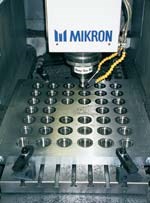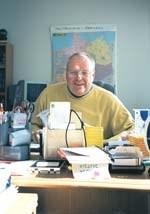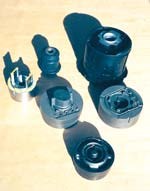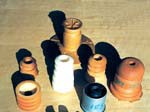When Faster Is Better
A German mold maker expands operations from Europe to America on the wings of high speed machining.
Share





For more than 30 years, Ingolf Steinkamp, chief executive officer of Steinkamp Mold and Tool (Espelkamp, Germany) has aggressively pursued metalworking excellence by combining a highly trained workforce with technologically advanced machine tools. After serving in the German army during his country's post-war reconstruction period, Mr. Steinkamp began his higher education in 1965 and earned his degree as an industrial master. Under Germany's educational system, people who earn this degree are eligible to establish apprenticeship programs to train others in the metalworking trade.
In 1970, with assistance provided through the Marshall Plan, Mr. Steinkamp established his original machine shop in Espelkamp. Although resources were scarce at the outset, Mr. Steinkamp capitalized on a simple idea to boost his shop's early growth. He designed and patented a simple and effective anti-theft device for ball-hitch trailers. This egg-shaped, metal device fits inside the ball socket of a trailer hitch and expands when actuated by turning a key in its internal lock cylinder. The product was such a great success that Mr. Steinkamp was able to finance the machine tools that placed his shop firmly on the road to success.
After gradually building his machining operation in Espelkamp for more than 20 years, Mr. Steinkamp discovered a second "magic egg" when his shop adopted high speed machining. In the relatively brief time since Steinkamp Mold began using HSM in 1996, the company has expanded its business by approximately 50 percent and doubled its workforce. The firm currently employs 150 people in Germany and 15 at its shop in Erlanger, Kentucky, established in 1999.
Last year, the firm earned approximately $10 million, primarily by producing tooling for manufacturers of automotive parts. The majority of Steinkamp Mold's tooling is used to manufacture vibration-damping devices for automobile engines and suspensions. Approximately 90 percent of the shop's work involves creating rubber injection molds, foam molds, blow molds and injection molds. These molds are typically machined from tool steels hardened to approximately 60 HRc.
Growing Pains
Unlike Mr. Steinkamp's trailer-hitch widget, experiencing the benefits of high speed machining was definitely not an overnight sensation. "It took us approximately 1½ years to develop proficiency with high speed milling," he says. "In the beginning, it was taking us 10 hours of programming time for each hour of machining time. We knew something had to be wrong with that scenario, so we continued to examine and refine our procedures."
This patience was rewarded when the shop's program-to-cut ratio was dramatically reversed—a trend that continues today. Once the initial learning stage was completed, Steinkamp Mold was in a position to expand its productive capacity and optimize other aspects of its manufacturing process. This is particularly advantageous in improving the firm's overall competitive position.
New Roots In Kentucky
Although the shop in Kentucky, is considerably smaller than Steinkamp Mold's Espelkamp operation, it employs the same type of highly trained workforce and sophisticated technology that characterizes the German shop. In fact, the majority of Mr. Steinkamp's Erlanger workforce consists of transferred workers who were trained in Germany.
Operating a total of 75 machines, Steinkamp Tool is currently the world's largest client for Mikron Machining Technology (Nidau, Switzerland), the parent company of Mikron Bostomatic Corporation (Milford, Massachusetts). The Kentucky shop incorporates a variety of equipment that includes nine milling machines, three turning machines, two grinding machines and two EDM machines (wire and ram types). Four of the shop's milling machines are Mikrons, including a 42,000-rpm high speed machine that incorporates a Bosch HS Plus CNC. The shop also operates an SV-503/40 high speed machine manufactured by Mori Seiki USA Inc. (Irving, Texas), two VF2 vertical machining centers manufactured by Haas Automation Inc. (Oxnard, California) and one VTC 250/50 machine manufactured by Mazak Corporation (Florence, Kentucky).
Perhaps providing a forecast of improving conditions in the automotive sector, Mr. Steinkamp says, "Our business here in the states is on a definite upswing and I expect this trend to continue throughout the remainder of this year. The same is true with regard to our German operations." With a full slate of work on his schedule, Mr. Steinkamp is already planning to expand the Erlanger shop into an adjoining area of his building.
Addition Via Subtraction
The ultimate value of HSM consists in its capacity to remove some conventional obstacles to process improvement. "If conventional machining is considered as one rail on the metalworking track, high speed milling now represents the second rail," says Mr. Steinkamp. When inspecting fine details of the firm's various mold components, one might assume that these features had been machined by ram EDM. But Steinkamp Mold has replaced many operations that formerly required EDM with precision, high speed milling. In addition, the surface quality that the shop now achieves by cutting metal at high speeds has completely eliminated the need to hand finish mold components. This saves the company a great deal of time while providing better accuracy and uniformity of parts.
Mr. Steinkamp optimizes his use of labor by designating the daytime shift primarily for roughing operations—when the need for operator intervention is more likely. He reserves his lights-out shift primarily for high speed finishing operations. The fact that tool crashes are considerably more likely during rough machining cycles points to another subtractive benefit of high speed machining. With proper programming, high speed machining cycles are much more likely than conventional machining cycles to run flawlessly. Considering the increasing amount of roughing and semi-finishing work that is now being performed at higher spindle speeds, this benefit is expanding to encompass a larger percentage of the overall process. For example, the cumulative effect of more rapid metal removal rates and related time/labor savings has reduced Steinkamp's production time by approximately 30 percent since the firm initiated HSM. The shop has also experienced a comparable reduction in lead times to customers.
Because Steinkamp Mold primarily produces tooling used to create a specific category of automotive parts, the shop hasn't experienced the same problems with customer data that commonly affect mold shops with more diverse customer bases. Normally, the data that Mr. Steinkamp receives from his customers is adequate for use without translation. By focusing on a specific industrial niche, therefore, the shop has removed another source of variation from its operations. At present, the Kentucky shop is operating with only one CAD designer on staff.
Machine operators who double as programmers represent important elements in the success of shops that make the most of high speed machining. "All of our operators are skilled programmers," says Mr. Steinkamp. Because HSM practices and procedures are constantly evolving at a rate reflecting the speed of the process itself, it's quite important for programmers to be in positions to observe the immediate effects of their strategies. Indeed, the conventional division of shop personnel into programmers and machine operators is inadequate as a scheme to develop and perfect these techniques.
Improved Heat Treatment
Many insert segments for the multiple-cavity molds produced by Mr. Steinkamp's shop have relatively long dimensions. These inserts incorporate portions of complex features that are created when the segments interlock within the mold base. This places substantial importance on eliminating metal deformation during heat treatment. In this regard, Mr. Steinkamp has been quite pleased with the results of a process known as plasma nitriding that avoids some key problems associated with conventional heat treatments.
During this process, the metal part is enclosed in an airtight chamber. After using a vacuum pump to evacuate air, water vapor and hydrocarbon contamination from the chamber, it's backfilled with a nitrogen/hydrogen mixture until the internal gas pressure reaches the level of approximately 2 Torr (atmospheric pressure is 760 Torr). This vacuum chamber is electrically grounded for safety and it's also connected to the positive terminal of a power supply. In turn, the metal part to be treated is connected to the negative terminal.
When power in the range of 200 to 1,000 volts is applied, electrons from the surface of the metal part are accelerated toward the chamber walls. In the process, these electrons collide at high speeds with nitrogen molecules in the gas mixture. These collisions create positively-charged nitrogen ions that, in turn, are accelerated by voltage to collide with the surface of the part at extremely high speeds.
This process initiates a glow discharge on the surface of the part. First, the colliding nitrogen ions dislodge iron molecules and surface contamination from the part's surface in a process known as sputtering. When sputtered iron atoms combine with neutral nitrogen atoms, iron nitrides are formed. After this compound is deposited onto the part's surface, continual ion bombardment breaks down the iron nitride to produce atomic nitrogen. This nitrogen diffuses into the metal to form a hardened zone of alloy nitrides near the part's surface.
The principal advantages of this hardening process are that less heat is required and no quenching is necessary. Typical temperatures for plasma nitriding range from 750° to 1,040° F. Because this is a diffusion process rather than merely a coating, it provides greater resistance to wear, fatigue and corrosion. The stress-relief action that accompanies this process is also superior to conventional methods because the glow discharge provides more uniform heat distribution. Plasma nitriding is capable of producing surface hardness values of 60-65 HRc and higher.
Mr. Steinkamp currently sends his mold inserts to Sun Steel Treating, Inc. (South Lyon, Michigan) for this treatment. "Using this process, we find there is virtually no distortion when the parts come back," he says. In a shop where substantial pride is taken to eliminate variations, this heat treatment method represents an important element in the integrity of the overall process.
The Training Challenge
Although Mr. Steinkamp admits that the difficulty of finding skilled metalworkers is universal, the Kentucky shop represents a greater challenge in this regard than his main operation in Espelkamp. Unlike the United States, Germany has a well-established system of dual education for trade and technical careers. Under this system, extensive cooperation exists between shop-based apprenticeship programs—for which employers bear the costs—and publicly funded classroom studies. Despite attempts to initiate a similar system in northern Kentucky, Mr. Steinkamp has found that local technical schools have been unreceptive.
As a short-term solution, the company relocates workers trained in Germany. But as the Kentucky shop continues to grow, Mr. Steinkamp faces the same labor shortage problem that other American shops are experiencing. "We have enough business to grow even faster here in Kentucky—but first we must find qualified people to support that growth," he says.
Regarding careers in metalworking, Mr. Steinkamp offers some interesting comparisons between the attitudes of young people in the United States and those in Germany. While many young Americans tend to view machine shop careers with disdain, he finds that young Germans are less likely to share this negative perception. Of course, the challenge of changing the ways young people think about metalworking careers is a topic frequently discussed by organizers of training and apprenticeship programs in the United States.
Faster In The Future
Shop owners who have adopted high speed machining typically view the process improvements they have already made as representing only the tip of the iceberg. It seems evident that substantial room exists for the future growth and refinement of these techniques.
On a daily basis, therefore, shops such as Steinkamp Mold are pioneering the practice of high speed machining. In the process, metalworking professionals are creating new techniques at a faster pace than ever before. With good reason, a definite sense of excitement surrounds these endeavors. This excitement is heightened by the fact that early adopters of HSM technology have achieved significant competitive advantages. For this reason, Mr. Steinkamp's principal goal for the future is to continually increase the percentage of his shop's overall output that is generated via HSM. Quite simply, when the high speed machines are running, his company is earning more money per part.
Related Content
How to Accelerate Robotic Deburring & Automated Material Removal
Pairing automation with air-driven motors that push cutting tool speeds up to 65,000 RPM with no duty cycle can dramatically improve throughput and improve finishing.
Read MoreRead Next
Prescription For Success
For an Ontario mold shop, higher cutting speeds meet the challenge of producing optical-quality surfaces.
Read MoreBuilding Out a Foundation for Student Machinists
Autodesk and Haas have teamed up to produce an introductory course for students that covers the basics of CAD, CAM and CNC while providing them with a portfolio part.
Read MoreSetting Up the Building Blocks for a Digital Factory
Woodward Inc. spent over a year developing an API to connect machines to its digital factory. Caron Engineering’s MiConnect has cut most of this process while also granting the shop greater access to machine information.
Read More
































